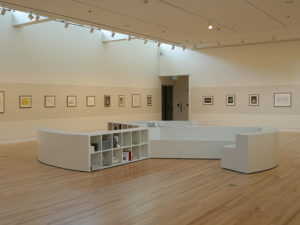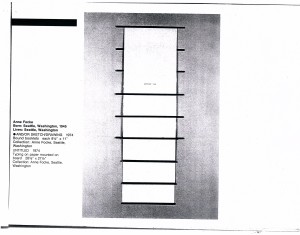Am I an artist? My inner jury has not reached a decision.
Though I left high school being very clear in my identity as an artist, my certainty got buried over time – not dismissed, just ignored. That identity and many questions triggered by it were tugged to the surface in late 2012, over 40 years later, by Scott Lawrimore’s invitation to create a piece for an exhibition at the Frye Art Museum the following spring. The decision was not an easy one. But many long walks and internal debates later, I agreed.
About the exhibition, Chamber Music, the museum said this:
Each artist created a newly commissioned artwork in response to musical compositions based on James Joyce’s volume of poetry entitled Chamber Music. The artists included in Chamber Music span generations and reflect a broad aesthetic spectrum. What unites them is a shared dedication to artist-generated activities that strengthen Seattle’s arts community beyond their own admirable art practices. Chamber Music is both a celebration of individual mark-making and a cooperative composition about love for the City of Seattle and how artists choose to leave their mark on it.
As a supplement to the thirty-six new works on view, the exhibition includes a living library archiving the artists’ contributions as curators, critics, academics, theoreticians, writers, civic organizers, and founders or members of important artist cooperatives and independent exhibition spaces.
I decided that my contribution – Get up! – would be an investigation in several parts: a wall piece made to fit within the prescribed dimensions, historical documents from and/or for my cubby in the “living library,” and a series of conversations and new writings as further extensions of the work.

One of those writings follows below. I was prompted to include it here by recent comments from Martha Wilson, an artist, friend, and unstoppable spirit who influenced me and many others during and long after and/or’s years. (Take a look at Franklin Furnace Archives Inc. to see why). In this essay, I wonder what happened to my artist self over the years. I mention my 1978 disappointment to discover that my artist/organizer peers, unlike me with my internal dialog, did not seem to ask whether their organizational work was an extension of their artmaking. Martha’s recent comments let me know I wasn’t alone after all. Back then my questions had, she said, reinforced her own view of her work. In a recent email, in fact, she lamented that not much has happened since the ‘70s to encourage seeing . . . “artists’ administrative work as an artistic practice – this idea still needs to be shouted from the rafters!” Though a blog post is hardly shouting from the rafters, here’s the piece I wrote for Chamber Music.
![]()
Am I still doing the work I was actually doing then?
The last time I was included in a museum show was in 1975. The Moore College of Art (Philadelphia) invited me to participate in a national traveling exhibition of drawings. They asked me to submit two recent drawings of my own and to invite four other artists from the Northwest to do the same. I chose Cheryl Cone, Bill Hoppe, Chris Jonic, and Ken Leback, who were pleased to be asked and comfortable with the deadline. My response was procrastination. This might have grown from a general insecurity about my drawing, but more important, I was well into a process of shifting my understanding of what my artwork was, from objects to something much less definable, something that involved, I thought, putting situations together – projects, organizations, focused activities. On top of that, and/or (a nonprofit place for artists that I helped found) was barely a year old, and finding time to produce two drawings was not a high priority. So I contacted the exhibition’s curator and told her that while the other four artists were prepared, I was not. I apologized, but told her there would be just eight pieces from the Northwest.
Not so quick, I found. Without my submissions, the other Northwest pieces could not be included; the premise of the show was “artists choosing artists,” and the work of the artist chooser was required. I couldn’t disappoint the other four. So, instead of pretending an interest in working with charcoal or video again, I took the tools I used most at the time, a ballpoint pen and a typewriter (no personal computers then), and attempted to “draw,” somehow, the work I was actually doing. Here are fragments of the result:
PATTERNS
a making possible
the patterns-I-make/work-I-do is functional like a container is functional
but I know that the patterns I make are not neutral – not simply a container for something else
“patterns” is somehow a useful word…designs, forms, scoresPATTERNS I make are not abstract – are patterns of people/artists, work, concerns, activities, energies
They are structures for people/energies/work to use, to happen in, to be supported by – encouraged by
It’s important for me to find ways to make sure the people/art/work/energy that moves through, that happens in “my” patterns, retains its own integrity – doesn’t become “mine”BUT the patterns I make have their own characteristics, are distinctly mine and not anyone else’s
the forms are large, moving, alive, they are between but include people/events/ideas
the visual sense (feel) of forms/patterns: soft edges, slow motion (though containers of rapid, even frantic, activity), porous
I fear the pattern becoming rigid, clearly defined, brittle-sharp
the forms are multiple, diverse…balanced multiple-y, a balance not simply between two
I wish that the form of this “drawing” could resemble the form of the work it refers to
… from “and/or sketch/drawing,”
produced for North, East, West, South and Middle,
an exhibition of contemporary American drawings
•
I have only vague memories of the actual “drawings” themselves, and I never saw the exhibition. It didn’t come to Seattle and travel wasn’t really an option then. The pieces were lost or damaged somewhere along the tour, and I never got them back. I recently found a folder with drafts of individual pages, bits of text, and old copies of bad photos of one of the pieces. A xerox of my page in the exhibition catalog includes an image of the other drawing, but gives no indication of the text inside the six hanging booklets. At least it had a kind of graphic grace on the wall. Most of the pieces in the show used drawing materials you might expect – ink, charcoal, pencil, crayon – and the catalog essay referred to a “recentering” of drawing. I imagined the disappearance of my pieces as some kind of retribution, not directed by anyone in particular, more by fate or the gods of “real art.”

•
In 1978, the first national gathering of “alternative visual arts organizations” took place in Santa Monica, California, attended by fifty-seven organizations, including and/or and the Portland Center for the Visual Arts from the northwest. I was asked to contribute an essay for an accompanying publication. As research, I spoke in advance with many of the artist organizers of other spaces. I wanted to find out what organizational patterns we had developed as “new arts spaces” – how we functioned and what shapes we had taken. I was also interested in the ways our organizations had changed.
An overriding memory from the conversations was of disappointment. I took on writing the essay because I thought it would give me a chance to talk with other artists who were thinking about the patterns of their organizational work. I was surprised that I didn’t find anyone who thought about making the organization as an extension of their artmaking. Maybe I didn’t ask the right questions. They often knew that being artists themselves was important to the work, but in most cases they also seemed to feel that the organizational work took them away from their art, and many of them longed to get back to it. Many worried about their spaces becoming institutions (though some explicitly sought that), while it seemed to me that their organizations followed existing organizational models without thinking much about it. Now, I find it curious that I didn’t write about my dismay. Perhaps I didn’t quite know how to bring it up or, as likely, was insecure about being so alone in my interest.
•
Especially when I found in my fellow artist-organizers no resonance with my curiosity about our work as artmaking, I just buried the question of my status as an artist. Determining whether the work was art, and by extension whether I was an artist, interested me much less than getting on with the work itself. I’ve never really liked “Is it art?” or “Is that art?” questions. Not only do they tend to be dismissive at least in popular parlance (My five-year-old could do that!), they have always seemed to beg the real question of whether the work (whatever it’s called) has value and if so what that value is. In a fairly conscious way, I decided then that my identity wouldn’t change simply by letting the words drop away. And besides, not making “art” meant I could stop spending time making objects to prove it.
The Frye’s invitation to participate in Chamber Music brings this inquiry to the surface again. It has caused me to dig up and look through old papers and records. It’s been fun reading and even learning from my nearly-40-year-younger self. What changes if I do something as an artist? What lines are crossed? In general I don’t draw lines very well, thinking here especially of lines between my work and the rest of my life.
Perhaps, though, the shift isn’t as linear as that. Perhaps instead it’s more like the apparently simple shift of attitude that can change everything. I’m reminded of David Mas Masumoto in his book Epitaph for a Peach who tells of the day he got rid in an instant of all the crazy-making weeds in his peach orchard. He redefined what was a “weed.”
• • • • •
Adapted from A Pragmatic Response to Real Circumstances, 2006, originally published by the Back Room, Portland, Oregon, now published as a Jank Edition by Publication Studio, also in Portland, and available in the Frye Art Museum Store during Chamber Music.
Part of Get up! for Chamber Music and the Frye Art Museum, 2013.
![]()
It’s nice that you mention the David Mas Masumoto peace about defining weeds at the end. Back in those days I often thought of your art/organizing as a kind of gardening. The space, the fertilizer, the water, and light all provided and the growth, the flowering, uncertain. Comparing it, your process, to painting, the people and their projects were the media, the space the canvas. Not your canvas alone of course.
The real flowering was the community and that was a great thing.
I know a nursery owner who tells me that the only plant that is a weed is one that you don’t want in your garden.
xx